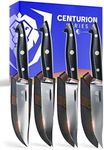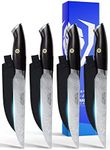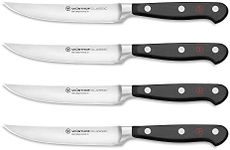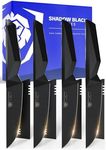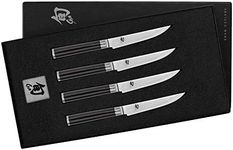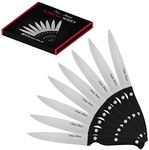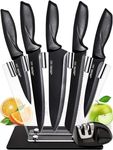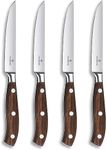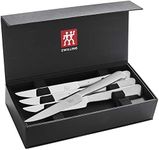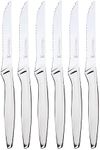Buying Guide for the Best Steak Knives
Choosing the right steak knives can make a big difference in your dining experience, whether you’re hosting a dinner party or enjoying a quiet meal at home. The right set will not only cut through meat easily but also feel comfortable in your hand and last for years. When shopping for steak knives, it’s important to consider a few key features that affect performance, comfort, and durability. Understanding these features will help you select knives that best fit your eating habits and preferences.Blade MaterialBlade material refers to what the knife blade is made from, and it’s important because it affects sharpness, durability, and resistance to rust. The most common materials are stainless steel and high-carbon steel. Stainless steel is popular because it resists rust and is easy to maintain, making it a good choice for most people. High-carbon steel can be sharper and hold its edge longer, but it may require more care to prevent rust. If you want low maintenance, go for stainless steel. If you’re willing to do a bit more upkeep for a sharper edge, high-carbon steel might be for you.
Blade EdgeThe blade edge is the shape of the cutting part of the knife, and it determines how the knife slices through meat. There are two main types: serrated and straight (non-serrated). Serrated edges have small teeth and are great for cutting through tougher meats or crusts without tearing, and they stay sharp longer. Straight edges give cleaner cuts and are easier to sharpen, but may need more frequent maintenance. If you often eat steaks with a tough exterior, serrated is a safe bet. If you prefer a smooth, clean cut and don’t mind sharpening, straight edges are ideal.
Handle MaterialHandle material affects how the knife feels in your hand and how easy it is to care for. Common materials include wood, plastic, and metal. Wood handles can look elegant and feel comfortable, but may need more care to avoid damage from water. Plastic handles are durable and easy to clean, making them practical for everyday use. Metal handles are sturdy and modern-looking, but can be slippery if wet. Choose a handle that feels comfortable and secure in your grip, and consider how much maintenance you’re willing to do.
Balance and WeightBalance and weight refer to how the knife feels when you hold and use it. A well-balanced knife feels stable and comfortable, making it easier to control. Heavier knives can feel more substantial and may cut through meat with less effort, while lighter knives are easier to handle for longer periods. Try to pick a knife that feels natural in your hand—if you have smaller hands, a lighter knife might be better, while those who like a solid feel may prefer something heavier.
Full Tang vs. Partial TangTang refers to how far the blade extends into the handle. A full tang means the metal of the blade runs the entire length of the handle, which usually makes the knife stronger and more balanced. Partial tang knives have the blade only partially inside the handle, which can make them less durable. If you want a knife that will last and feel sturdy, look for full tang construction.
Dishwasher SafetyDishwasher safety is about whether the knives can be safely cleaned in a dishwasher. Some knives, especially those with wooden handles or certain blade materials, can be damaged by dishwasher heat and detergents. If you prefer easy cleanup, look for knives labeled as dishwasher safe, but keep in mind that hand washing is often recommended to extend the life of any knife.
